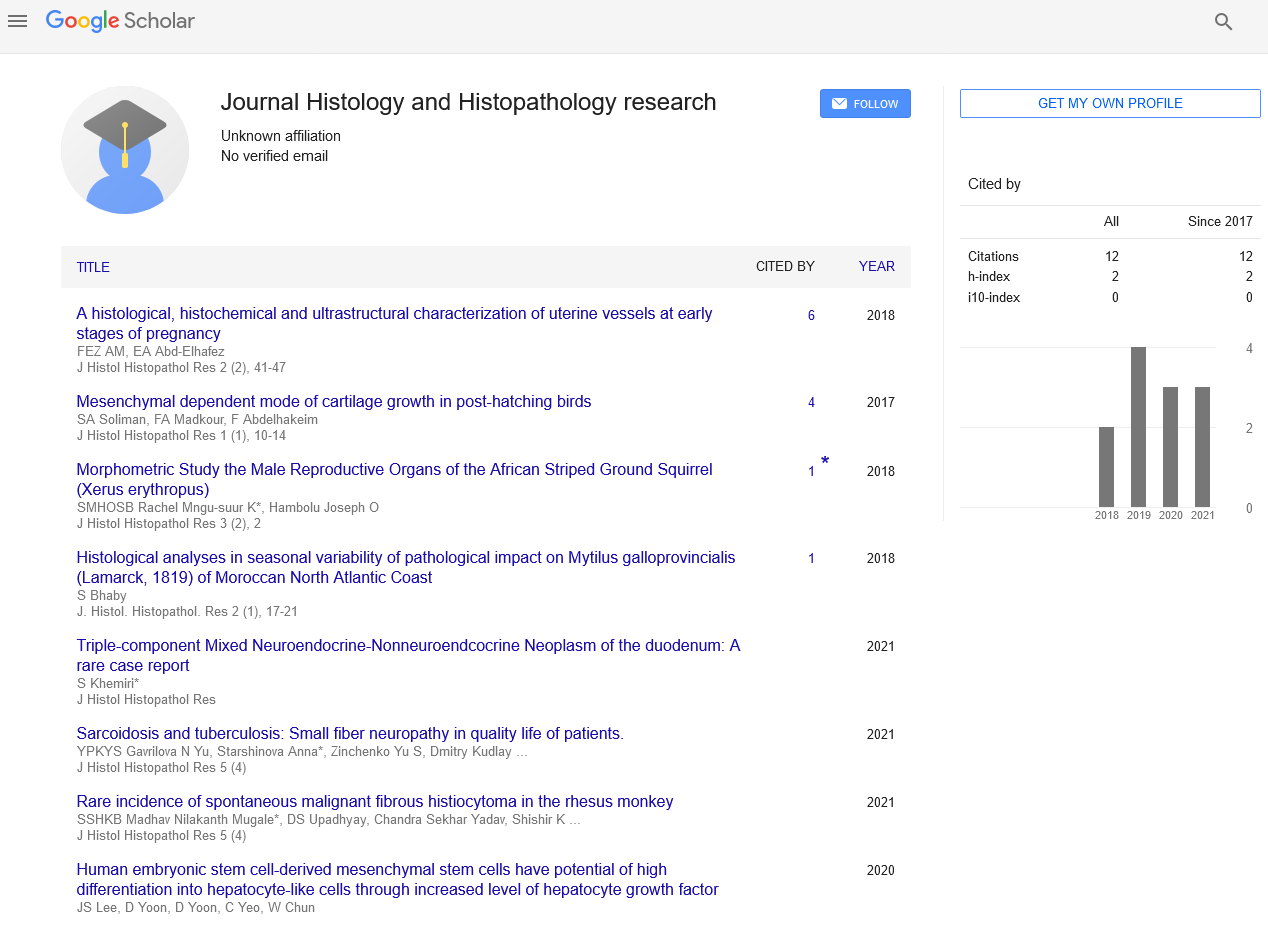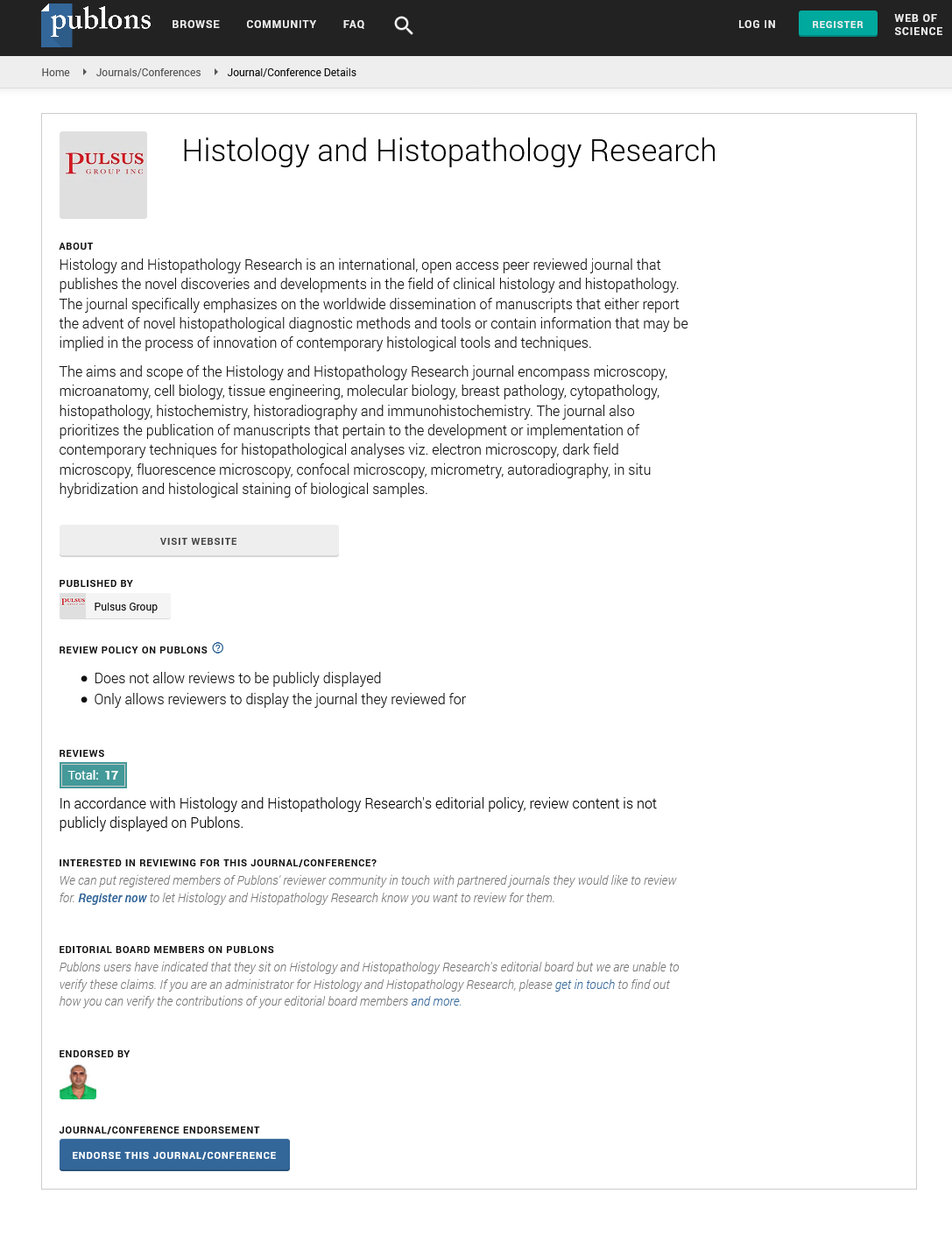Concentrated antibody standardization for use in automated immunohistochemistry
Received: 07-May-2022, Manuscript No. PULHHR-22-5092; Editor assigned: 09-May-2022, Pre QC No. PULHHR-22-5092 (PQ); Accepted Date: May 23, 2022; Reviewed: 20-May-2022 QC No. PULHHR-22-5092 (Q); Revised: 22-May-2022, Manuscript No. PULHHR-22-5092 (R); Published: 29-May-2022, DOI: 10.37532/ pulhhr.22.6(3).70-71
Citation: Williams K. Concentrated antibody standardization for use in automated immunohistochemistry. J Histol Histopathol Res.2022;6(3):72-73.
This open-access article is distributed under the terms of the Creative Commons Attribution Non-Commercial License (CC BY-NC) (http://creativecommons.org/licenses/by-nc/4.0/), which permits reuse, distribution and reproduction of the article, provided that the original work is properly cited and the reuse is restricted to noncommercial purposes. For commercial reuse, contact reprints@pulsus.com
Abstract
Immunohistochemistry (IHC) is a diagnostic and research tool for detecting proteins in cells or tissues. It has acquired an essential supporting function in the molecular diagnosis of specific neoplasias in modern pathology, with an exponential contribution in customized therapy. Through standardization, aut- -omation in immunohistochemistry assists to lower test variability. The transition to automation is a process, and if a laboratory already has a collection of stock concentrated primary antibodies, these antibodies should ideally be compatible with the chosen automated method, as antibodies are too valuable to be discarded as a result of the migration to automated immunohistochemistry.
Keywords
Immunohistochemistry; Antibody; Pathology
IMMUNOHISTOCHEMISTRY
Immunohistochemistry (IHC) is a diagnostic and research tool for detecting proteins in cells or tissues. It has acquired an esse- -ntial supporting function in the molecular diagnosis of specific neoplasias in modern pathology, with an exponential contribution to customized therapy. Through standardization, automation in immunohistochemistry assists to lower test variability. The transition to automation is a process, and if a laboratory already has a collection of stock concentrated primary antibodies, these antibodies should ideally be compatible with the chosen automated method, as antibodies are too valuable to be discarded as a result of the migration to automated immunohistochemistry.
Immunohistochemistry is a method that uses antigen-antibody interaction to detect proteins in cells or tissue components, and it is an essential tool in the identification and localization of a range of antigens. IHC is at the crossroads of classical pathology, pathology identification based on microscopic morphological analysis, and molecular diagnostics. Aside from its remarkable value as a tool for categorizing neoplasms in the era of personalized medicine, IHC has become critical for the right classification of cancer patients for target-specific therapies.
IHC has at least three major contributions to contemporary pathology:
• Diagnostic—primarily, the use of antibodies for the diagnosis of undifferentiated neoplasms, the determination of primary site in metastatic diseases, and neoplasm subtyping.
• Genetics—the analysis of gain or loss of protein expression due to changes in genes and the mutational state of certain biomarkers
• Therapeutic—through the analysis and quantification of tissue expression, IHC results can determine the best treatment option and predict response to a target.
Despite the fact that IHC is a commonly used approach in diagnosis and research, there is a lack of standardization, which may contribute to intra- and interlaboratory differences. Preanalytical considerations such as sample fixation are among the obstacles that pervade IHC, as are analytical factors such as antibody selection (monoclonal or polyclonal), detection system selection, use of controls, and endogenous protein and enzyme inhibition.
It is not practical to standardize a single procedure across all laboratories, however, methods within a single laboratory should be standardized to ensure repeatability. This necessitates rigorous attention to the guidelines when performing the method. Given its inherent consistency and control, automation is clearly the only way to attain performance uniformity, just as it is in clinical analysis laboratories. Among the primary benefits of deploying IHC automation are protocol standardization and the ability to increase workload without sacrificing quality. Monitoring mistakes in processes, such as insufficient temperature and reagent quantities, expiry date management, and reagent inventories, is also critical. The kinetics in automation, heating, and evaporation control ensure a homogenous environment that leads to repeatable outcomes, optimizing and quickening the proc-processes. Variations in the flexibility of reagent usage in automation platforms gave birth to the names "open" and "closed" systems. Closed systems provide more uniformity but less flexibility. Open-system platforms, on the other hand, allow for a simple transition from a manual routine to an automated one through reagent flexibility, including the use of manual routine antibodies and protocol customization; hence, open platforms are preferred in research. Laboratories that use manual immunohistochemistry have concentrated antibodies on hand; however, these commercially important reagents would be wasted during the move to automation.
In this study, the laboratory already had an antibody portfolio and chose a platform that accepts antibodies from other suppliers, prompting us to wonder if good immunostaining with concentrated antibodies from other suppliers could be obtained in the Benchmark automation platform XT-Ventana Medical Systems. As a result, we will test the idea that it is feasible to employ concentrated antibodies from different manufacturers on the Benchmark XT automation platform with good immunostaining. The study has some drawbacks. First, immunostaining of concentrated antibodies could not be compared to ready-to-use equivalents. Because the primary reason for the investigation was the presence of antibody stocks in the laboratory, the laboratory did not purchase the corresponding ready-to-use stocks advertised by the manufacturer. The opportunity to test automation in this laboratory was contingent on the availability of a portfolio of pr- -e-existing concentrated antibodies, which represented money invested. Second, no negative controls were employed in the standardization, and the goal of using negative controls is to establish that the observed response is caused by the interaction of the target protein epitope and the antibody parotope. Finally, a response cost analysis for both human and automated systems is provided.
Many considerations make establishing a global standard procedure for IHC impractical, and it is up to each laboratory to select and confirm the process for each marker, whether the technique is automated or not. The standardization of an antibody for automated usage is part of the shift to automated IHC in open systems that allow the use of concentrated antibodies. The manufacturer's guidelines are a nice place to start in this scenario.
If one chooses an automated platform to do immunohistochemistry based on the data reported here, it is feasible to employ concentrated antibodies that may already be in the laboratory, either for cost reasons or because a manufacturer does not have the required antibody. Standardization must be repeated for each additional equipment or antibody. In big facilities with a high number of antibodies, standardization might be a difficult challenge. Standardization, with the prospect of a migration to this incremental innovation, should serve as a subsidy for a conscious migration in all sections of the laboratory, particularly among pathologists, technicians, and administrators.






